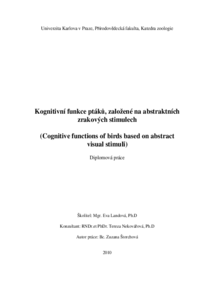Kognitivní funkce ptáků založené na abstraktních zrakových stimulech
Cognitive functions of birds based on abstract visual stimuli
diplomová práce (OBHÁJENO)

Zobrazit/
Trvalý odkaz
http://hdl.handle.net/20.500.11956/31744Identifikátory
SIS: 64024
Kolekce
- Kvalifikační práce [19597]
Autor
Vedoucí práce
Konzultant práce
Nekovářová, Tereza
Oponent práce
Němec, Pavel
Fakulta / součást
Přírodovědecká fakulta
Obor
Zoologie
Katedra / ústav / klinika
Katedra zoologie
Datum obhajoby
20. 9. 2010
Nakladatel
Univerzita Karlova, Přírodovědecká fakultaJazyk
Čeština
Známka
Výborně
Klíčová slova (česky)
holub, prostorová kognice, abstraktní vizuální stimuly, dotyková obrazovkaKlíčová slova (anglicky)
pigeons, spatial cognition, abstract visual stimuli, touch-screenProstorová orientace holubů na malé škále byla intenzivně studována v pokusech, využívajících různých typů arén či bludišť. V těchto experimentech holubi většinou hledali potravu ukrytou v cílovém místě a orientovali se podle poskytnutých orientačních bodů. Rozvoj nových technologií umožnil testovat prostorovou kognici holubů také ve virtuálních úlohách, založených pouze na schematickém znázornění arény nebo bludiště na dotykové obrazovce. V experimentech tohoto typu holub označuje cíl klovnutím a je odměněn potravou z krmítka, umístěného v blízkosti monitoru. Studie, prezentovaná v této diplomové práci, byla založena na kombinaci obou typů prostorových úloh. Klíčová informace pro nalezení cíle byla holubům promítána na monitoru počítače v podobě grafického stimulu, avšak cílem samotným byl jeden ze 4 otvorů v rozích průhledné obdélníkové desky, umístěné před monitorem. Experiment s podobným návrhem ve studiu prostorové kognice holubů dosud nebyl publikován. Testovány byly dva typy abstraktních grafických stimulů. První z nich poskytoval prostorovou informaci o umístění cíle a měl podobu malého obdélníkového rámečku s bílým bodem vždy v jednom z svých rohů. Rámeček představoval prostor odpověďové desky, bílý bod pak pozici cílového otvoru. Druhý stimul neobsahoval implicitní prostorovou informaci o...
Spatial orientation of pigeons on a small scale was intensivelly studied in experiments using various types of arenas or mazes. In these experiments pigeons usually searched for food hidden in the goal area and they based their orientation on available landmarks. The development of new technologies allowed to test spatial cognition of pigeons also in virtual tasks, based exclusively on a schematic representation of an arena or maze on a touch screen. In experiments of this type pigeon marks the goal by pecking and it is rewarded by food from a feeder, located near the monitor. Study presented in this diploma thesis was based on combination of both types of spatial tasks. The information crucial for locating the goal was presented to pigeons on a computer screen in form of graphic stimuli, whereas the goal itself was formed by one of the 4 holes in corners of a transparent rectangular desk, standing in front of the monitor. Experiment with similar design was not yet published in the study of spatial cognition of pigeons. Two types of abstract graphic stimuli were tested. The first stimuli provided a spatial information about the location of a goal and had a form of small rectangular frame with a white spot in one of its corners. The frame represented the space of the response desk and the white spot...
